When summer comes to an end and the leaves start to change, it is time to start thinking about RV winterization and storage. Once we have prepared to protect the plumbing, and electrical systems, and protected the rig from winter critter visits, it is time to consider whether or not to cover the RV?
An RV cover is a great way to protect your RV from things like rain and snow, twigs and bird droppings, but there is a pretty healthy debate over whether they are a good idea. Once you have decided to use a cover, then you must find the best RV cover for your rig and climate.
In this article, we’ll discuss the pros and cons of covering your RV, what to consider when choosing covers, and we’ll offer our recommendations for the best RV covers for every climate.
Recommended RV Covers
Best Budget RV Cover
Best RV Covers For Summer and Sunny Climates
Best RV Covers For Rainy Climate
Best RV Covers For Winter and Snowy Climates
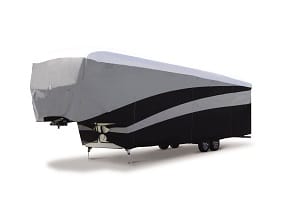
Camco
Ultra Shield Series
- Covers for most models
- UltraSonic welds 40% stronger
- Dupont Tyvek Top panel
Honorable Mention: Oxford Cloth RV Covers
If you shop RV cover reviews on Amazon, you will see that most have between 10% and 20% poor reviews (1-2 stars.) This almost always has to do with poor seams and tearing. The problem is that the materials used in most RV covers give up strength in favor of softness and light weight.
In recent years, a new type of RV and motorhome cover is becoming very popular. These covers are crafted from high-quality Oxford cloth material that boasts remarkable strength, ensuring that your RV remains shielded against a myriad of environmental factors. The tightly woven fabric acts as a formidable barrier, safeguarding your vehicle from the damaging effects of UV rays, preventing color fading, cracking, and deterioration of interior components.
Furthermore, the Oxford cloth’s water-resistant properties provide a reliable defense against rain, snow, and other moisture, effectively preventing the formation of mold, mildew, and rust. Beyond its robust protective features, these RV covers are also designed for ease of use, often equipped with reinforced straps and buckles for a secure fit even in windy conditions.
The breathable nature of the Oxford cloth helps in proper air circulation, minimizing the risk of condensation and promoting a healthier environment inside the RV.
So far the reviews have been very good. However, most of these type of covers do not have a lot of reviews yet. Time will tell, but Oxford covers may be worth watching in the future.
Should You Cover Your RV in Winter?
If you have not chosen a side in the Great RV Cover Debate (yes there really is one), we hope to help you here. Just to let you know right up-front, we fall on the pro side of the issue.
We are full time RVers, but we did store the RV during the winter of 2018 while we were spending time with my mom in Michigan during her last few months. We did cover the rig against the Michigan weather and had a very good experience.
That being said, we have looked extensively at both sides of this issue and here are the pros and cons.
The Pros For Buying an RV Cover:
Obviously, the biggest benefit of covering your RV is protection from the elements. Rain and snow, UV rays, dust and mildew are all threats to the overall look and longevity of your RV. These can cause structural damage, paint damage, rust, tire breakdown and other issues. RV covers protect the rig from these environmental issues.
Snow melt can lead to water trapped in crevices; when that freezes it can cause serious structural issues. The cover can help protect against that. However, keep in mind that the weight of snow can still cause damage even if you have a cover. You may still need to go up on the roof and shovel off snow.
If properly applied and used, an RV cover is the best way to protect your trailer while you are storing it.
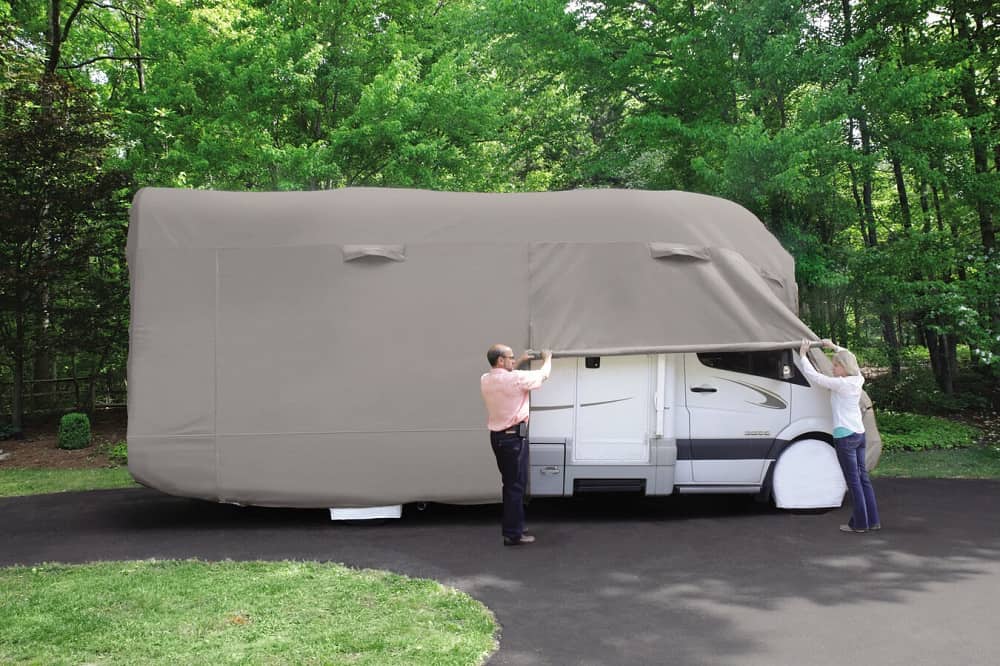
The Cons For Buying an RV Cover:
On the flip-side, there are some potential hazards to consider with an RV cover!.
When covering your RV, you will likely need to get up on the roof to make sure it is properly adjusted. You need to be careful not to fall or damage anything up on the roof, or yourself!
If the cover is not well designed or not well installed, water and wind can get under the cover. Trapped water is one of the biggest threats to your RV, potentially leading to mildew and even structural damage from ice.
Poorly tied down covers may catch the wind, leading to rips and tears in the cover, or even damage to your RV from the fabric beating against the finish.
Do RV Covers Cause Mold?
Properly chosen and installed RV covers do not cause mold. Mold is always a potential problem for RV’s in any kind of damp weather and the secret to avoiding it is proper ventilation. When putting an RV in storage it is important to choose the right cover, and have it properly installed.
Wet shady areas are a perfect breeding ground for mold and mildew, so it is important NOT to create that sort of environment. A well built waterproof RV cover will have air vents built in to allow air flow underneath the cover. This integrated air vent system will dry any condensate quickly, avoiding mold growth.
A tarp or lower quality cover may allow condensation or water accumulation underneath, which will almost certainly lead to mold and mildew. If you have a high-quality cover, but do not tie it down properly, it can trap water inside leading to mold. SO adjustable tension panels should be included on the cover to help keep it tight.
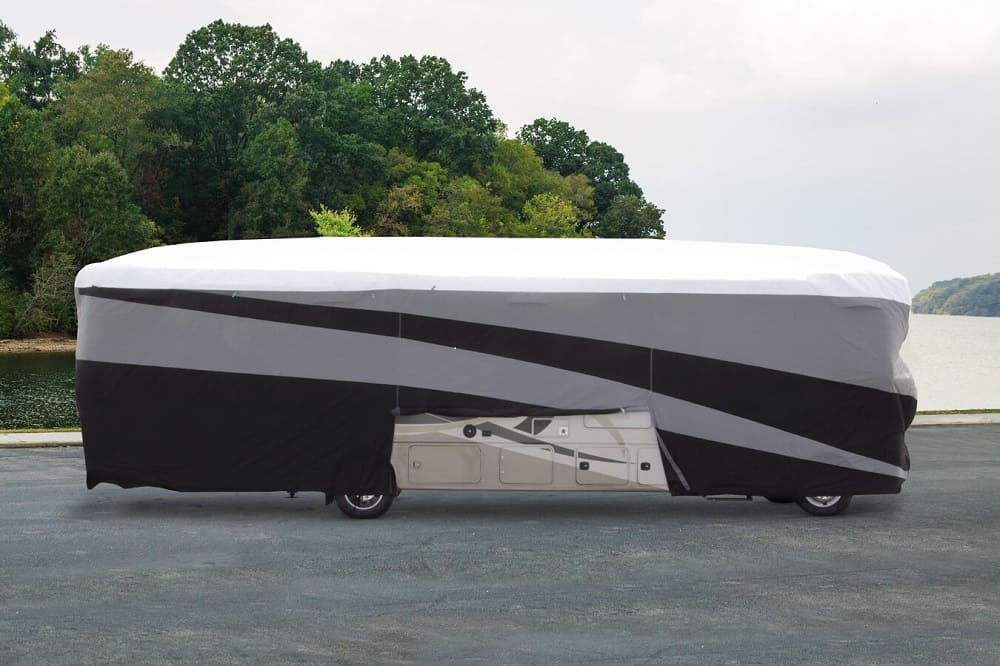
Should You Cover Your RV With A Tarp?
Tarps are not designed to cover RVs and may actually cause more problems than they solve.
Unlike a good RV cover, tarps do not breathe and are likely to trap moisture underneath them. This trapped water can expand when it freezes and cause damage, or if it accumulates it will lead to mold and mildew.
Tarps are not designed to be securely fastened to an RV and may catch the wind or shred against sharp edges, either of which may lead to damage. They do not last very long. While versatile during their early use, they quickly shred and fray, which can lead to all of the issues discussed above.
Are RV Covers Worth The Money?
RV covers usually cost anywhere between $150 and $400 and will last, on average, three to six years. They prevent UV damage to your paint and exterior. They prevent structural damage due to water accumulation and freezing.
The can help protect your RV from dust, bird droppings, and scratches from wind-borne debris. Tires can cost hundreds of dollars each, while tire covers cost $30 to $60 for a set of four. The tire cover will protect against breakdown caused by UV exposure.
Repairing any of these issues can easily outstrip the cost of the cover itself. Ultimately, the covers are worth their cost and more.
What To Look For When Buying An RV Cover
There are many covers on the market. When you are buying a cover for your RV there are several aspects you should consider: the type and size of your RV and the materials and features of the cover.
Type Of RV
While there are many sizes and types of RVs, it is important to know that manufacturers make covers for all of these RV’s. A Class C RV cover will not fit a travel trailer, and a Class A RV cover will not fit a fifth wheel. So whether you tow a pop up camper, a small fifth wheel, or a massive Class A bus, there is an RV cover for you.
Size Of RV
When you chose a cover, you will want to ensure it is compatible with your specific RV, but you also want to sure that it fits the specific size and measurements of your RV. It should fit snugly to prevent moisture, dust, or wind getting underneath.
The complication is that when you measure height, length, and width, you need to include all the other exterior elements that should add inches to your measurements. Your RV likely includes storage racks, ladders, bumpers, and mirrors.
Ensure that you provide enough leeway in your RV measurement to account for all of that. Most RV manufacturers will supply measuring instructions to get the best fit.
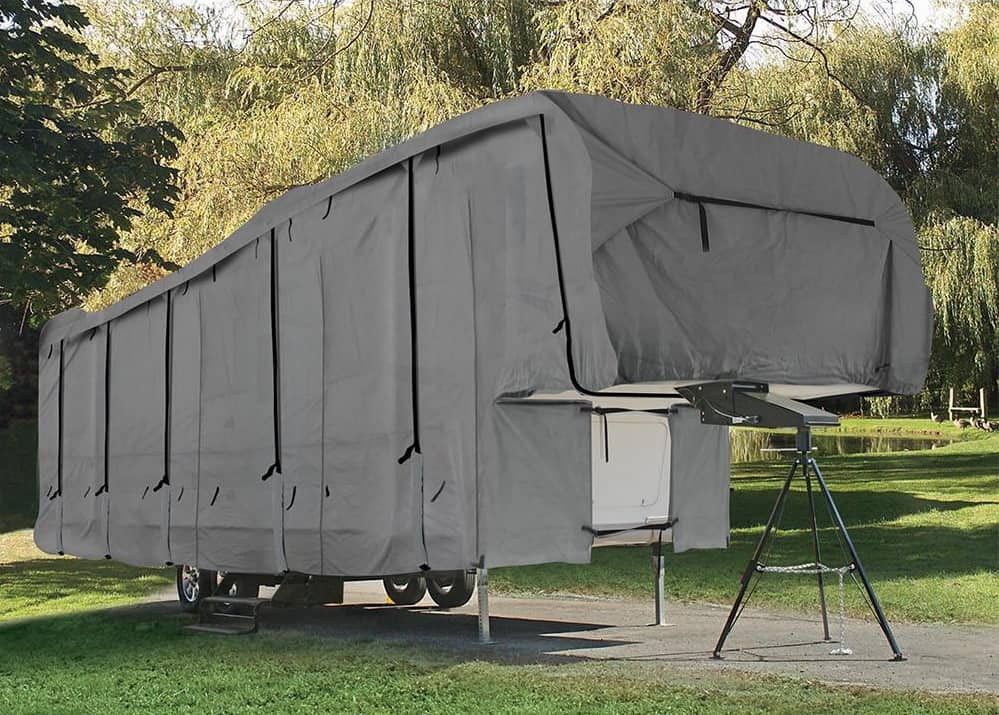
Custom Covers
Many covers can be “customized” to fit your RV better. Adjustable front and rear tension panel systems will allow you to pull certain areas more snug than others. These are regular covers with additional tie-up features.
You will know these because the sizes of RV’s they cover will come in the form of a “range.” When we bought our cover, it said it would fit fifth wheels from 36’ to 40’.
There are also manufacturers that will actually create a custom cover for your RV. In this case, you measure your RV from the two longest points (this might be the front bumper to the rear ladder) and supply that information to the manufacturer.
You will also need to supply additional specifications such as the RV’s year, make, and model. They will create custom motorhome covers, travel trailer covers, or just about anything you need. Consult the custom cover manufacturer to get instructions for measuring your specific rig.
What Type Of Material is Best?
The type of material you will want is determined, in large part, by the climate in which you are storing your RV. Quality RV cover materials vary across manufacturers, but you want to consider these climate types and the type of weather protection you will need. Which best matches yours?
The Sunny and Dry Climate
Some materials are best in the southwestern climate. Covers geared for this climate will sun protection (temperature and UV damage) as well as dust and sand. These tend to be lighter and very breathable.
You may wish to consider tire covers as well, particularly if you are in a sunny climate. Long exposure to the sun’s UV rays will age your tires rapidly, leading to cracks and breakdown. Covers will help protect the tires from these issues.
The Cold and Rainy Climate
Others are better for northern climates. Covers geared for this climate tend to be water repellent and will help prevent mold. They help protect the RV exterior from snowfall accumulation.
The Moderate and Varied Climate
If you are storing your RV in different locations, or if your region’s weather patterns vary across extremes, there are also covers designed to handle a little of everything.
Features To Look For In A New RV Cover
RV covers vary widely by cost and features. When you shop the cover there are a few key features you want to consider.
- Layers: Some are single layered, but you can also get them in double and triple layers. The question is how much protection from wind and the elements or the sun and heat do you need?
- UV Protection and Water Repellent: Few things can damage a stored RV like the sun and rain and snow. If you expect your RV to withstand either of these, ensure you get a cover that addresses them.
- Tie-Down systems: These keep the cover on, prevent it from moving in the wind, and help to ensure the dust and water do not get up underneath the cover. They tend to secure on the underside of the RV to ensure extra security against these issues.
- Integrated Air Vent Systems: help to ensure adequate airflow under the cover to prevent mold growth. They will also help in windy conditions, preventing wind from catching in the cover and pulling it around. This can lead to rips in the cover or damage to the RV.
- Zippered Access Panels: Zippered panels are designed to align with your doors and allow access to your RV even when they are covered in storage. Make sure to check the locations of these openings prior to purchasing the cover.
- Roof-Only Covers: These covers are designed only to cover the roof of the RV. These are designed to keep your RV roof protected from the sun as well as bad weather.
- Elasticized Hem Corners: The lower edge and corners should have elastic to wrap under the rig and hold the cover firmly in place. Less movement means less potential damage to the finish.
- Wheel Covers: All weather protection applies to the wheels as well. A goood wheel cover protects the rubber from dry rot and UV damage.
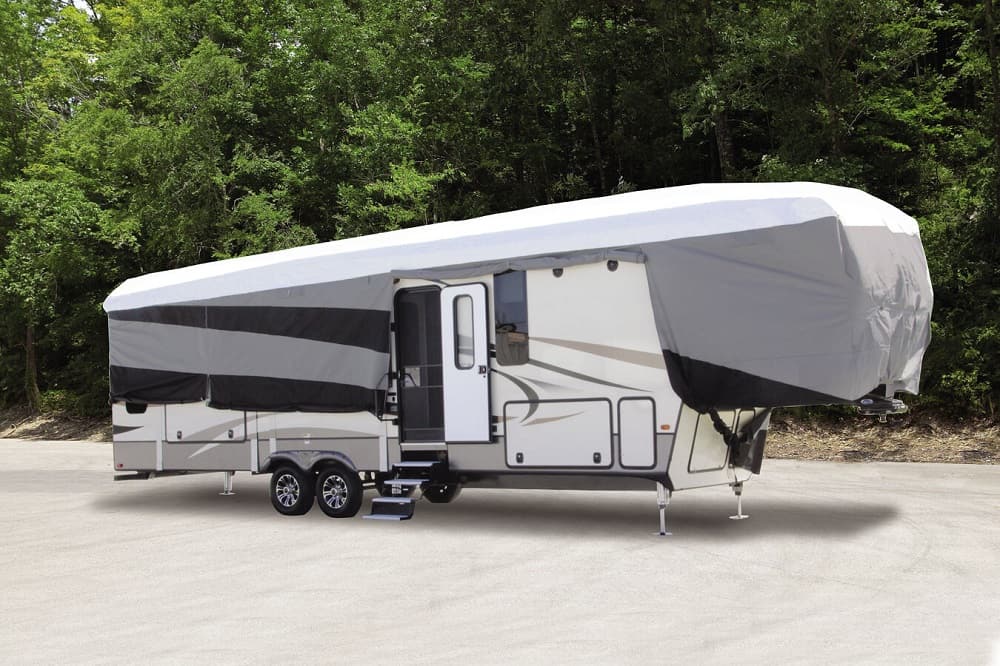
How Long Does An RV Cover Last?
The life of an RV Cover varies widely. Obviously, you can extend the life of a cover if you install it properly, so that it is not pulling and snagging on part of the RV in wind. Cleaning it and storing it properly will help as well.
A multi-layered cover will be a more durable cover than single layers. RV covers last anywhere from 3-7 years. When you purchase the cover, check the length of warranty. Many come with a 1-year warranty, but some will come with a 5-year warranty.
These warranty lengths are a good indication of how long the manufacturer expects the RV cover to last (under the best conditions).
How Do I Keep My RV Cover From Ripping?
Just as you need to protect your RV, you also need to protect the cover.
When not using it, you should keep the cover in a storage bag to keep it dry. There are several “danger spots” for your cover: bottom and side corners, which tend to be sharp; gutter spouts if you have them; protrusions on the roof including AC, vent covers, or skylights; steps and awnings.
Check Out These Awesome Gutter Covers From CampingWorld
Essentially, anything that sticks out of the main body of the RV and anything with a sharp edge presents a danger to your cover.
Your best option is to cover these with a soft material. Some people use heavy towels, sponges or small blankets. Others use pool noodles and tennis balls cut in half.
Any sponge or rag that you use to clean a car will likely have enough body and toughness to do this job. Tape these different items to anything with a sharp edge.
How Do I Cover My RV?
It is best to have a partner. Getting the cover even, particularly if the wind is blowing can be a challenge. Be safe climbing up and moving around on the roof and be mindful of where your vents, skylights, and anything else are. Once you cover them, they are not easy to see.
Before you do anything else, if you are going to cover sharp edges or anything that sticks out from the exterior hull, now is the time. This will help prevent the cover from snagging on any sharp edges and tearing.
You can cover these edges in Styrofoam, pool noodles, towels or heavy sponges. Tape these items over your sharp edges.
Use a ladder, or the built-in ladder, to get up on the roof. Take your time and move very carefully. Pull the cover carefully up onto the roof.
Lay out the cover over the roof and line up the corners. Drop it down on each of the sides. Climb down and even out the cover on all four sides. If you have an elastic hem, pull the hem below the edges of the RV.
Buckle up the front and back straps and then the sides. If you are lucky, the straps come with weighted toss bags so that you do not have to crawl under the RV and can just “toss” it under to the other side. Ensure that the entire cover is snug and even.
Hopefully you now have all of the information you need to choose the right RV cover for your rig, to keep it safe and protected throughout its storage.

Frank Foley
Frank is the Head Hubby, Daddy, and Fix-It Guy of the Roving Foleys clan. He ia an avid traveler and has spent over 5 years traveling full time with his family. he loves helping others learn about the RV life. He has also traveled in Europe, Asia, and Australia with his wife Grainne.



